
|
Figure 1: This staged photo is arguably the most famous of the many handshake photos taken between American and Soviet soldiers that were posed to commemorate the historic Link-Up. According to historian Dr. Uwe Niedersen, author of "Elbe Link-Up" (2005: Demand Society Encounters Europe e.V.). International News war correspondent Allan Jackson quickly arranged and snapped two photos, this being one of them, on April 26, 1945 at about 12:00— the day following the actual Link-Up. The soldiers that Jackson gathered were sightseeing, trading Vodka and chocolate, as well as comparing weapons and cameras. The American 69th soldiers pictured (left) were attached to Colonel Charles M. Adams, 273rd Inf Rgt Commander, and were in Torgau preparing for the formal meeting between the American 69th's General Reinhardt and the Soviet 58th's General Russakov. According to Dr. Niedersen, Col. Adams' report identifies Bernard E. Kirschenbaum, Regtl Hq 273rd Inf Rgt, as "the American in the middle of the photo" or second from left; confirmed by the Octagonian Vol. XCVI, No. 2, Summer 2008, p. 1 ("Bernard E. Kirschenbaum, Cornell ’46 (second from left), then with the U.S. 69th Infantry Division. Kirschenbaum later finished his education and became an accomplished architect and sculptor"). Norman Barratt, Regtl Hq 273rd Inf Rgt, wrote in The Fighting 69th Bulletin (Vol. 49, No. 2, Jan-Apr 1996, p. 39) that the third 69er from the left is Richard Johnson, Regtl Hq 273rd Inf Rgt. The Soviet soldier next to Johnson in the center of the photo is Lt. Charles Thau, a Pole drafted into the Soviet Army in 1943. Source: Joe Lipsius, Regtl Hq & Cn Co 272nd Inf Reg. |

|
| Figure 2: American 2nd Lt. William D. Robertson (left, 69th Infantry Division, 273rd Infantry Regiment) and Soviet Lt. Alexander Silvashko (right, 58th Guards Division) embrace in a 50th Anniversary painting of the Link-Up. They were leaders of their respective patrols that met at 1600 on the blasted Elbe River Torgau Bridge on 25-April-1945. This painting was commissioned for Elbefest 2005. For more information on this painting and the event it commemorates, click here. |
Elements of the 69th Infantry Division 273rd Infantry Regiment met soldiers from the Soviet 58th Guards Division on April 25, 1945 in the vicinity of Torgau, Germany on the Elbe River. This first meeting of the Allied troops climaxed a long-sought goal to break the German Army apart, which was perfected on this spring day in 1945. Routes of the three patrols from the 273rd Inf Rgt re shown on the Linkup Map below. The times of contact were as follow:
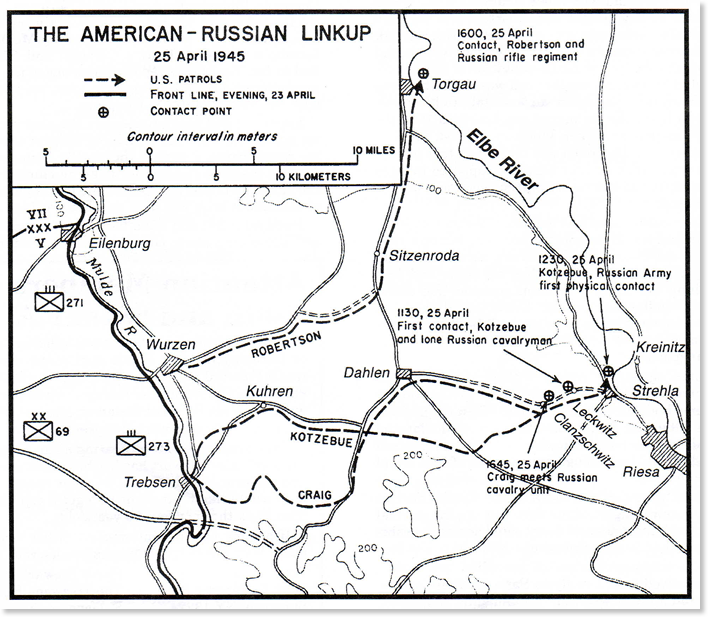 |
| Figure 3: The American-Russian Linkup Map showing the locations of the 69th Inf Div 273rd Inf Rgt's first contact with elements of the Soviet 58th Guards: (1) 1130 & 1230 Kotzebue Patrol, (2) 1600 Robertson Patrol, and (3) 1645 Craig Patrol. (1130=11:30 AM; 1230=12:30 PM; 1600=4:00 PM; 1645=4:45 PM). |

|
| Figure 4 (above) & Figure 5 (below): These Linkup maps were furnished by Jim Straight, PhD, PE, Los Alamos National Laboratory, Los Alamos, New Mexico. Jim's father was a WWII Company Commander, 654th Engineering Topographical Battalion. His Company was called on to produce a pair of different maps for the Linkup ceremony. The maps were very fancy with gold leaf on the borders. Just before the ceremony, it was discovered the Russian General's name was misspelled. The error was quickly corrected but there was not enough gold leaf for his name on all of the maps. Only a few were fully corrected. Jim's father kept the prototype (no gold leaf). Click here for a larger version of Fig. 4, and Click here for a larger version of Fig. 5. |
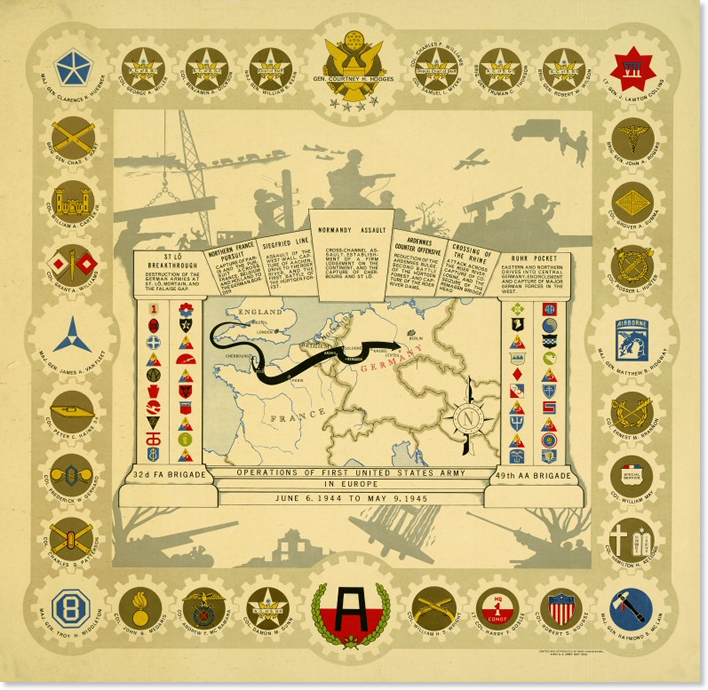
|
The most famous feat of the 69th Infantry Division and its Attached Units—its WWII glory, if you will—is that this was the first Allied unit to meet up with the Soviet Army. This Linkup is also often referred to as the day when "East Meets West." These U.S. Army organizations had a total of more than 16,000 men. Did this large number of men meet the Soviets (a.k.a. Russians)? The answer is no.
In WWII, an American Infantry Division's manpower strength was about 14,500 men. The majority were in fighting Units known as Regiments, with about 3,250 men each. These soldiers were the front-line troops. The 69th Infantry Division's Infantry Regiments (Inf Rgt) were the 271st, 272nd and 273rd. Commanding each Regiment was an officer with the rank of Colonel. Assisting him were a second-in-command and four staff officers. Two of the staff officers looked after the administration and the supply for the Regiment (the S-1 and S-4), while the other two (the S-2 and S-3) assisted the commander in moving the Regiment and fighting the enemy. I (Joe Lipsius) was the S-2 of the 272nd Inf Rgt. Each Regiment was further divided into three Battalions (Bn) of five Companies (Co) and five supporting Companies.
The Linkup with the Russians on April 25,1945, became known the following day to the command and staff of the 272nd Regiment. At that time, it was ordered to move from area of Wiederitzsch, north of Leipzig, to guard movements on the road between Eilenburg and Torgau, Germany and areas adjacent to the road. This was a distance of about 25 miles that stretched from the Mulde River on the west to the Elbe River on the east.
The soldiers involved in this historic moment are passing on -- veterans of the 69th Infantry Division, 461st Anti-Aircraft Artillery (AAA) AW Bn, 661st Tank Destroyer (TD) Bn, and 777th Tank Bn are fading away fast. So it's essential now to document certain aspects of the events of that day so that relatives and later generations can know the story of East Meets West in clear terms.
When it boils down to the facts of the linkup, actually three different encounters happened and only 91 men were involved, including two men not from the 69th. All of the 69th men were from the 273rd Inf Rgt. The 91 men were on what were termed "patrols." And some of these men may not have seen any Russians because of their duty assignment. Only four of these men are known to be alive today: Harold R. Brummell, of Lees Summitt, MO and James W. Kane, of Bryn Mawr, PA, both of Co G 273rd Inf Rgt and Igor N. Belousovitch of Falls Church, VA and Stanford J. Silvestri, of Delray Beach, FL, both of Co E 273rd Inf Rgt. All of the Linkup veterans names are shown on the 69th Infantry website under the Link or Button Hot Links, with some photos and details.
These three patrols became known as the Kotzebue Patrol, Robertson Patrol and Craig Patrol, named after their leaders and termed No 1, 2 and 3 in the order of their meeting the Soviets on that fateful day of April, 25, 1945.
The leader of Patrol No 1 was 1st Lt. Albert L. Kotzebue, Co G 273rs Inf Rgt, Houston, TX. Leading Patrol No 2 was 2nd Lt William D. Robertson, Hq 1st Bn 273rd Inf Rgt, Los Angeles, CA. And the leader of Patrol No 3 was Major Fred W. Craig, Hq 2nd Bn 273rd Inf Rgt, Friendship, Tn.
The events of the day of the Linkup were known only to a few persons at the time it happened. Only because of a report known as "The Fox Report," published immediately after the Linkup, as well as Unit histories after the war, articles in the 69th Inf Div Association bulletins, and later published research by Americans, Russians and Germans have details of the patrols' movements and actions along with photographs become known in recent years.
"The Fox Report" was the work of Captain William J. Fox, Brooklyn, New York. He was from the V Corps' 2nd Information and Historical Section. He accompanied the Craig Patrol. After the three meetings, he interviewed the leaders of Patrols 1 and 2. He also interviewed Major General Emil F. Reinhardt, 69th Inf Div Commander, Colonel Charles M. Adams, 273rd Inf Rgt Commander and Major Victor G. Conley, 1st Bn 273d Inf Rgt Commander, all involved in issuing orders to Unit commanders or the patrol leaders. Presumably, this report was ordered by V Corps commander Major General Clarence R. Huebner. We don't know how widely the report was distributed. In March, 2005, after an exchange of messages, Harold R. Brummel revealed he had a copy of the report and had one copied for me. He recalls being asked if he wanted a copy some years ago but not by whom. Harold was a member of the Kotzebue Patrol No 1.
In April 1995, the 50th Anniversary of the Linkups, a very detailed report of the Robertson Patrol No 2 movement and Linkup was printed in Torgau, Germany, by historian Karl-Heiz Lange. Lange wrote his report in cooperation with American William "Bill" Robertson, and Russian Alexander Silvaschko leader of the Russian patrol which met Roberson's patrol in Torgau, and others who were on or near the scene with access to information as to what happened. This report was in German only, and though four editions have been issued, all were in German. A typed English version of the first editon was sent to me by "Bill" Robertson before the printing of the first edition at the request of Lange because I was questioned by him about some of the happenings. An autographed copy of the German fourth edition was sent to me by Karl-Heinz following our meeting in person in Torgau on April 25, 2005, at the 60th Anniversary celebration of the Linkup.
Dr. Uwe Niedersen, another German historian, published "Elbe Begegnung Link-Up" in April, 2005, based primarily on "The Fox Report" including photos. This book is in German and English. He followed this book in April, 2007, with another using the same title but with many more details of the Linkup due to newly discovered information released from American, Russian and German war archives. Again, German and English were used.
While not all members of the 69th Inf Div were able to meet with the Russian soldiers, all played a part in making this historic achievement possible. With Germany cut in half by the Linkup of the U.S. and Russian armies, the end of the war in Europe was only a matter of weeks away. All 69th veterans and their families can take pride in the Fighting 69th's role in ending the horrific reign of the Nazis over Europe.
Joe Lipsius, Jan. 24, 2008
Joe Lipsius
Hq 272nd Inf Rgt
6314 Deerings Hollow
Norcross, GA 30092-1800
(770) 416-7725
annejoelip@bellsouth.net
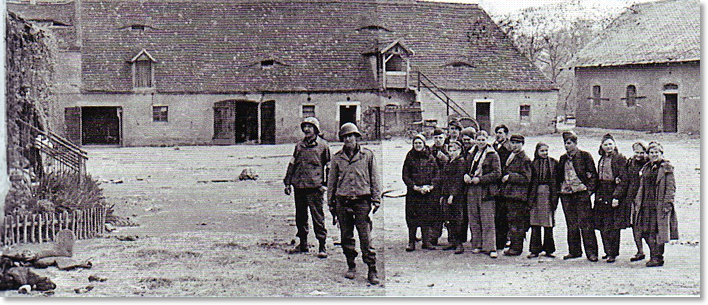
Figure 6. Kotzebue Patrol 11:30AM. At this farmhouse courtyard near Leckwitz, Germany stands 1st Lt. Albert L. Kotzebue, Co G 273rd Inf Rgt with one of his men, where at 11:30 AM, April 25, 1945 elements of his patrol met a lone Soviet cavalryman from Kazakhstan. The first meeting of the Americans and Russians in WWII. "He was extremly reticent. He was quiet, reserved, aloof, not enthusiastic. The first meeting of the two Armies certainly was not one of wild joy, but rather of cautious fencing. Or, perhaps, the Russian was just plain stupified and couldn't realize what had happened.
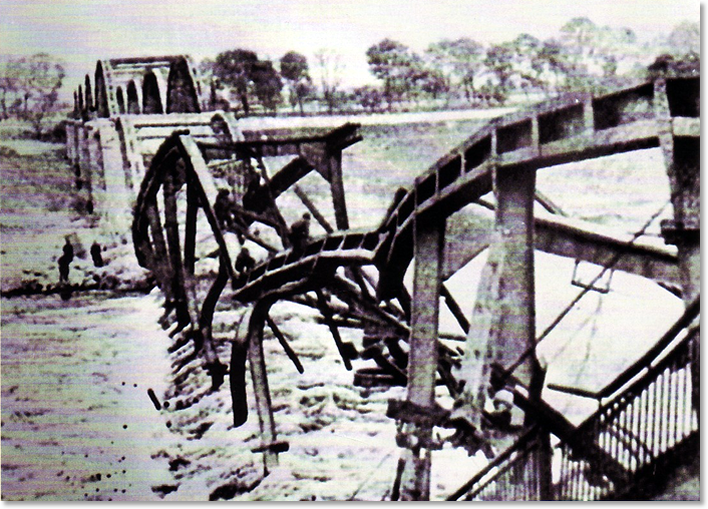
Figure 7. Robertson Patrol 1600 (4:00 PM). The scene at the damaged bridge over the Elbe in Torgau about 1600, April 25, 1945. Americans 2nd Lieutenant William D. Robertson and Pfc Frank Huff, Hq 1st Bn 273rd Inf Rgt climbing the steel skeleton of the blasted bridge over the Elbe River in Torgau to meet Soviet Lieutenant Alexander Silvashko and Sergeant Nikolai Andrejew, 58th Guards Division.
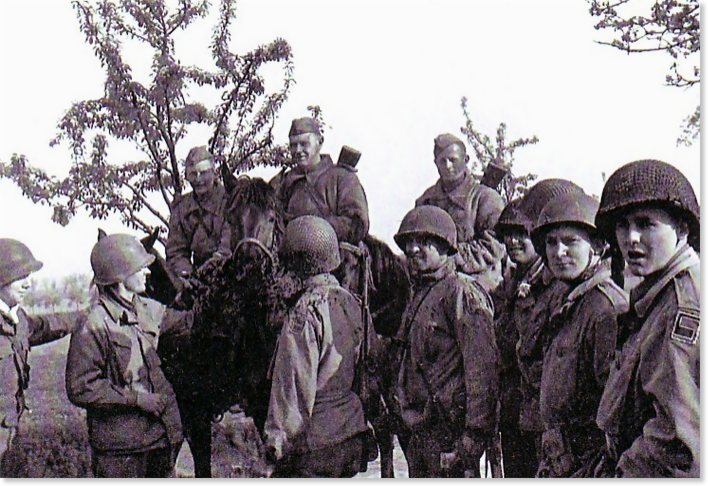
Figure 8. Craig Patrol 1645 (4:30 PM). Major Fred W. Craig, Hq Co 2nd B 273rd Inf Rgt, second from the left, reaches out to a Soviet soldier on his horse. His patrol had been searching for the Kotzebue patrol when it encountered the Russians at Clanzschwitz at 1645 April 25, 1945.

Figure 9. Allan Jackson International News Photo. This posed photo, symbolic of the American-Soviet Link-Up, was one of the two most famous photographs of WWII. It was taken by Allan Jackson, International News war correspondent.
On April 26, 1945 after photographing American and Soviet generals and VIPs at the scene of the Torgau, Germany historic linkup of April 25, Jackson decided to take a picture of soldiers from the two sides shaking hands. He quickly gathered sightseeing American and Soviet soldiers and posed them; taking two pictures that became symbolic of the meeting of two great powers at the Elbe. The photographs appeared in newspapers all over the world in the next few days—without captions identifying the soldier's names. This made identifying the soldiers difficult.
Ten years later the Jackson International News photo appeared in the Milwaukee Journal Sentinel newspaper in an article about the 10th anniversary of the American-Soviet Link Up. A reader thought that one of the soldiers in the photo looked like a Polish-born service station operator he knew named Charles Thau. When he showed it to Thau, Thau confirmed that he was indeed the Soviet soldier in the center of the photo. Thau was a Lieutenant who had been conscripted into the Soviet Army in 1943 after the Soviet Union annexed the part of Poland where he lived and had been hiding in the woods for the previous 19 months. He emigrated to the United States after the war. (Source: Son Jeff Thau, Dec. 1, 2010)
According to German historian Dr. Uwe Niedersen, author of "Elbe Link-Up" or in German "Elbe Begegnung Link-Up Photo Report 25-27 April 1945" (2005: Demand Society Encounters Europe e.V.), the American 69th soldiers pictured on the left side of the photo were attached to Colonel Charles M. Adams, 273rd Inf Rgt Commander, and were in Torgau preparing for the formal meeting between the American 69th's General Reinhardt and the Soviet 58th's General Russakov. According to Dr. Niedersen, Col. Adams' report identifies Bernard E. Kirschenbaum, Regtl Hq 273rd Inf Rgt, as "the American in the middle of the photo" or second from left; because Norman Barratt, Regtl Hq 273rd Inf Rgt, wrote in The Fighting 69th Bulletin (Vol. 49, No. 2, Jan-Apr 1996, p. 39) that Richard Johnson, Regtl Hq 273rd Inf Rgt, is the third soldier from left to right.
* * *
Note: The RTV commentator in this video says that no photos of the first
Link-Up encounters were taken. Photos were taken. See Figures 6, 7 & 8 above.
Site support by Leader Technologies® — provider of Leader Phone® audio conferencing and teleconferencing services.